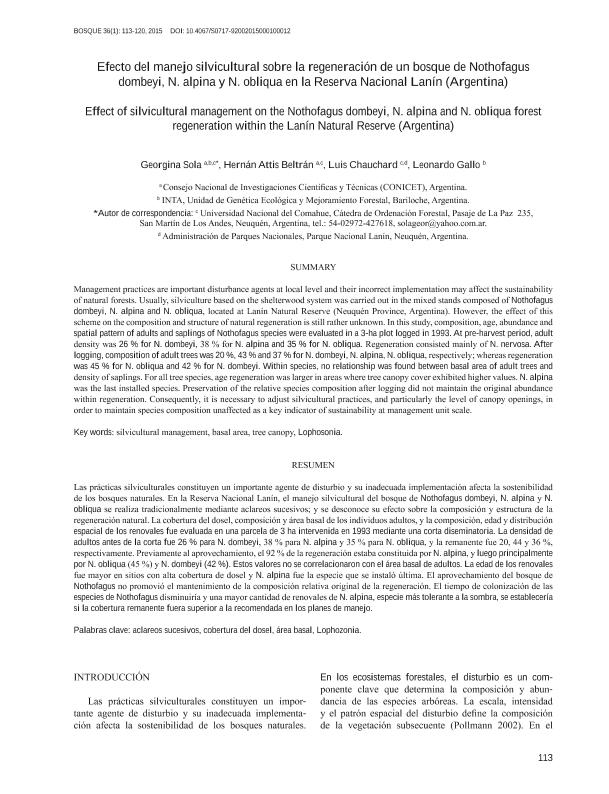Artículo
Las prácticas silviculturales constituyen un importante agente de disturbio y su inadecuada implementación afecta la sostenibilidad de los bosques naturales. En la Reserva Nacional Lanín, el manejo silvicultural del bosque de Nothofagus dombeyi, N. alpina y N. obliqua se realiza tradicionalmente mediante aclareos sucesivos; y se desconoce su efecto sobre la composición y estructura de la regeneración natural. La cobertura del dosel, composición y área basal de los individuos adultos, y la composición, edad y distribución espacial de los renovales fue evaluada en una parcela de 3 ha intervenida en 1993 mediante una corta diseminatoria. La densidad de adultos antes de la corta fue 26 % para N. dombeyi, 38 % para N. alpina y 35 % para N. obliqua, y la remanente fue 20, 44 y 36 %, respectivamente. Previamente al aprovechamiento, el 92 % de la regeneración estaba constituida por N. alpina, y luego principalmente por N. obliqua (45 %) y N. dombeyi (42 %). Estos valores no se correlacionaron con el área basal de adultos. La edad de los renovales fue mayor en sitios con alta cobertura de dosel y N. alpina fue la especie que se instaló última. El aprovechamiento del bosque de Nothofagus no promovió el mantenimiento de la composición relativa original de la regeneración. El tiempo de colonización de las especies de Nothofagus disminuiría y una mayor cantidad de renovales de N. alpina, especie más tolerante a la sombra, se establecería si la cobertura remanente fuera superior a la recomendada en los planes de manejo. Management practices are important disturbance agents at local level and their incorrect implementation may affect the sustainability of natural forests. Usually, silviculture based on the shelterwood system was carried out in the mixed stands composed of Nothofagus dombeyi, N. alpina and N. obliqua, located at Lanín Natural Reserve (Neuquén Province, Argentina). However, the effect of this scheme on the composition and structure of natural regeneration is still rather unknown. In this study, composition, age, abundance and spatial pattern of adults and saplings of Nothofagus species were evaluated in a 3-ha plot logged in 1993. At pre-harvest period, adult density was 26 % for N. dombeyi, 38 % for N. alpina and 35 % for N. obliqua. Regeneration consisted mainly of N. nervosa. After logging, composition of adult trees was 20 %, 43 % and 37 % for N. dombeyi, N. alpina, N. obliqua, respectively; whereas regeneration was 45 % for N. obliqua and 42 % for N. dombeyi. Within species, no relationship was found between basal area of adult trees and density of saplings. For all tree species, age regeneration was larger in areas where tree canopy cover exhibited higher values. N. alpina was the last installed species. Preservation of the relative species composition after logging did not maintain the original abundance within regeneration. Consequently, it is necessary to adjust silvicultural practices, and particularly the level of canopy openings, in order to maintain species composition unaffected as a key indicator of sustainability at management unit scale.
Efecto del manejo silvicultural sobre la regeneración de un bosque de Nothofagus dombeyi, N. alpina y N. obliqua en la Reserva Nacional Lanín (Argentina)
Título:
Effect of silvicultural management on the Nothofagus dombeyi, N. alpina and N. obliqua forest regeneration within the Lanín Natural Reserve (Argentina)
Fecha de publicación:
04/2015
Editorial:
Universidad Austral de Chile
Revista:
Bosque (Valdivia)
ISSN:
0304-8799
e-ISSN:
0717-9200
Idioma:
Español
Tipo de recurso:
Artículo publicado
Clasificación temática:
Resumen
Palabras clave:
ACLAREOS SUCESIVOS
,
COBERTURA DEL DOSEL
,
AREA BASAL
,
LOPHOZONIA
Archivos asociados
Licencia
Identificadores
Colecciones
Articulos(SEDE CENTRAL)
Articulos de SEDE CENTRAL
Articulos de SEDE CENTRAL
Citación
Sola, Georgina Giselle; Attis Beltran, Hernan; Chauchards, Luis Mario; Gallo, Leonardo; Efecto del manejo silvicultural sobre la regeneración de un bosque de Nothofagus dombeyi, N. alpina y N. obliqua en la Reserva Nacional Lanín (Argentina); Universidad Austral de Chile; Bosque (Valdivia); 36; 1; 4-2015; 113-120
Compartir
Altmétricas




